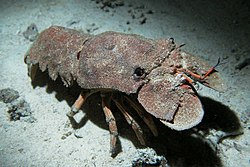| Scyllarides Temporal range: | |
|---|---|
 | |
| Scyllarides latus | |
| Scientific classification | |
| Kingdom: | Animalia |
| Phylum: | Arthropoda |
| Class: | Malacostraca |
| Order: | Decapoda |
| Suborder: | Pleocyemata |
| Family: | Scyllaridae |
| Subfamily: | Arctidinae |
| Genus: | Scyllarides Gill, 1898 |
| Type species | |
| Scyllarus aequinoctialis Lund, 1793 [1] | |
Scyllarides is a genus of slipper lobsters.